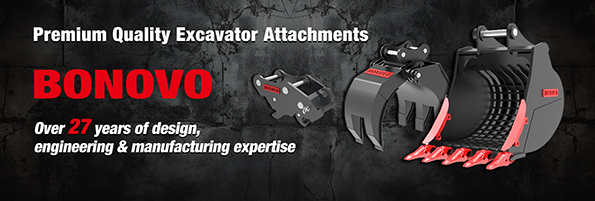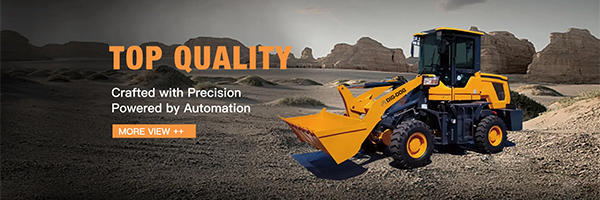Small loader
drop bucket failure phenomenon: When the pilot valve operating handle is in the middle, the bucket will automatically tilt forward and drop the bucket.
Fault analysis: According to the connecting rod mechanism of the working device, when the bucket is in the state of receiving the bucket and the operating handle of the pilot valve is in the middle position, the large cavity of the rotating bucket cylinder is under pressure due to the dead weight of the bucket. At this time, as long as the pressure oil of the large chamber is leaked relative to the oil return port, it will cause the bucket to automatically tilt forward.
There are six ways to cause the oil leakage from the large cavity of the rotating bucket cylinder to the return oil port:
First, the pipe fittings, joints and the joint surface of installation between the large chamber of the rotating bucket cylinder and the distributing valve have obvious external leakage.
Second, the rotating bucket reversing valve stem of the distributing valve fails to return to the center position (due to the valve stem of the reversing valve being stuck, the valve core of the rotating bucket large cavity pilot valve failing to reset due to stuck, and the trachoma internal leakage of the valve body of the rotating bucket large cavity pilot valve), so that the small chamber of the rotating bucket cylinder is connected with the pump port, and the large chamber is connected with the oil return port.
Third, when the oil cylinder of the rotating bucket is leaking, the small cavity of the rotating bucket is also leaking relative to the oil return port.
Fourth, the pressure of the large cavity overload valve of the rotating bucket cylinder is too low (due to the broken pressure regulator spring, the valve core has dirt stuck in the open position, and the sand hole or groove on the valve body is connected with the oil return chamber, etc.).
Fifth, the large cavity oil filling valve of the rotating bucket cylinder is leaking (due to the broken return spring, the valve core has dirt stuck in the open position, the combination cone of the valve core and the valve body has dirt or groove defects, and the sand hole on the valve body is connected with the oil return chamber, etc.).
Sixth, excessive wear of the reversing spool or valve hole makes the matching gap between the spool and the valve hole much larger than the design value, resulting in pressure oil leakage in the large cavity of the rotating bucket cylinder.
To eliminate the bucket fault, it should be carried out around the above six leakage paths:
(1) Around the above six leakage situations, the simplest and easiest to judge is the first situation: start the small loader
and lift the boom to a certain height, the bucket is collected to the maximum position, and observe whether there is obvious leakage between the pipe fittings, joints and the installed joint surface between the large chamber of the rotating bucket cylinder and the distribution valve.
② If no external leakage occurs in the first case, the second case can be judged: start the small loader
and operate the pilot valve handle to raise the boom to the highest position and the bucket to the maximum position → the engine is turned off and the pilot pipe at both ends of the distributing valve rotating bucket valve stem is removed. At this time, if the bucket drop phenomenon disappears, it can be determined that the pilot valve causes the distribution valve rotating bucket valve stem to not return to the center, resulting in the bucket drop phenomenon, should be removed and cleaned pilot valve or replace the pilot valve. Otherwise, the third case should be judged!
③ For the third case, we can make some simple judgments: Start the small loader
and operate the pilot valve handle to lower the boom to the lowest position, tilt the bucket back to the maximum position → Turn off the engine and open the swivel cylinder large chamber hose and lead it back to the hydraulic tank → Start the machine and operate the pilot valve handle to tilt the bucket back → Observe whether hydraulic oil continuously emerges from the swivel cylinder large chamber oil port. If there is continuous emergence of hydraulic oil at this time, it means that the rotary bucket cylinder has serious internal leakage, and the cylinder needs to be dismantled, repaired or replaced. If the cylinder does not leak, the fourth and fifth cases should be further analyzed.
④ For the fourth and fifth cases, we can use the pressure detection method to determine: Connect a pressure gauge with a measuring range of 0 ~ 25MPa to the pressure port of the large chamber of the rotating bucket cylinder → Start the machine → operate the pilot valve handle so that the bucket is in the maximum forward position → Increase the throttle and operate the pilot valve handle to lift the boom at the same time, observe that the reading of the pressure gauge during the boom lifting process should reach the design value (22MPa). Otherwise, one or both of the two leakage situations are true, and the rotating bucket cylinder large cavity overload valve or oil refill valve should be removed and cleaned.
(5) If the first to fifth cases are excluded in the case of bucket drop phenomenon does not disappear, should stop, the boom and bucket to the lowest, remove the distribution valve of the rotating bucket valve stem, carefully check the valve stem and valve holes and their cooperation, etc.
Choose BONOVO for high-quality, customizable brush cutters for skid steers with fast delivery. Contact us today to discover how our superior products can enhance your land management tasks!
for more info just visit our website at www.bonovogroup.com
contact # : +86 158 6218 2088
email : sales@bonovogroup.com
How to check and analyze the bucket failure of small loaders?
- BONOVO
- Counselor
- Posts: 645
- Joined: Oct 17th, '24, 02:50
- Location: China

